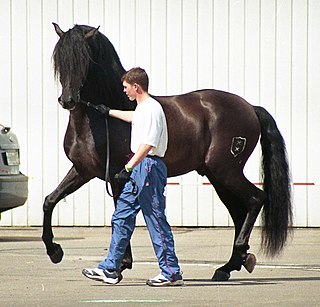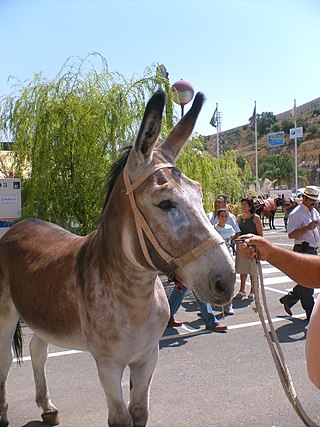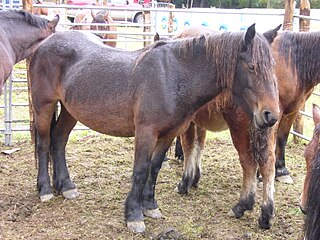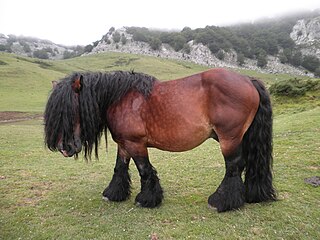
The Azteca is a horse breed from Mexico, with a subtype, called the "American Azteca", found in the United States. They are well-muscled horses that may be of any solid color, and the American Azteca may also have Paint coloration. Aztecas are known to compete in many western riding and some English riding disciplines. The Mexican registry for the original Azteca and the United States registries for the American Azteca have registration rules that vary in several key aspects, including ancestral bloodlines and requirements for physical inspections. The Azteca was first developed in Mexico in 1972, from a blend of Andalusian, American Quarter Horse and Mexican Criollo bloodlines. From there, they spread to the United States, where American Paint Horse blood was added.

The Galician or Galician Mountain Horse, Spanish: Caballo de Pura Raza Gallega, Galician: Raza Equina Cabalo Galego do Monte, is a breed of small horse from Galicia, in north-western Spain. It is genetically very close to the Garrano breed of northern Portugal. It was in the past used as a war-horse and in agriculture; it is now raised for shows and riding. They are very useful for ranchwork. The horses are bay or black.

The Pottok or Pottoka, is an endangered, semi-feral breed of pony native to the Pyrenees of the Basque Country in France and Spain.

The Chilean Corralero or Chilean Criollo is the Chilean national breed of Criollo horse. Like all Criollo horses, it descends from horses brought to the Americas from Spain by the Conquistadors.

The Hispano-Árabe is a Spanish horse breed originating from the cross-breeding of Arab and Andalusian horses.

The Mallorquín or Caballo Mallorquín is a rare breed of horse indigenous to the island of Mallorca in the Balearic Islands, from which it takes its name. Identification of the breed was begun in 1981 by the Patronato para las Razas Autóctonas de Mallorca. The Mallorquín is listed in the Catálogo Oficial de Razas de Ganado de España in the group of autochthonous breeds in danger of extinction.

The Andalusian, also known as the Pure Spanish Horse or PRE, is a horse breed from the Iberian Peninsula, where its ancestors have lived for thousands of years. The Andalusian has been recognized as a distinct breed since the 15th century, and its conformation has changed very little over the centuries. Throughout its history, it has been known for its prowess as a war horse, and was prized by the nobility. The breed was used as a tool of diplomacy by the Spanish government, and kings across Europe rode and owned Spanish horses. During the 19th century, warfare, disease and crossbreeding reduced herd numbers dramatically, and despite some recovery in the late 19th century, the trend continued into the early 20th century. Exports of Andalusians from Spain were restricted until the 1960s, but the breed has since spread throughout the world, despite their low population. In 2010, there were more than 185,000 registered Andalusians worldwide.

The Rubia Gallega, Galician: Rubia Galega, is a breed of cattle native to the autonomous community of Galicia in north-western Spain. It is raised mainly for meat. It is distributed throughout Galicia, with about 75% of the population concentrated in the province of Lugo. The coat may be red-blond, wheaten, or cinnamon-coloured.
The Retuertas or Caballo de las Retuertas is a Spanish breed of horse indigenous to Andalusia. It is found only in the Doñana National Park in the provinces of Huelva and Sevilla, with a conservation herd in the Campanarios de Azaba Biological Reserve in Espeja a part of which is the research reserve of the Consejo Superior de Investigaciones Científicas, the Spanish National Research Council.

The Andalusian, Spanish: Asno Andaluz, is a Spanish breed of domestic donkey. It is native to the province of Córdoba in Andalusia, and may also be known as the Asno Cordobés after the city of Córdoba or the Asno de Lucena because of its alleged origin in the town of Lucena, Córdoba. It is an endangered breed, and is classified by the Ministerio de Agricultura, Pesca y Alimentación, the Spanish agriculture ministry, as an "autochthonous breed in danger of extinction".

The Asturcón is an ancient Spanish breed of small horse or pony from the autonomous region of Asturias in the northern part of the country. It has been documented since Roman times: it has an unusual ambling gait, which was described by Pliny the Elder in his Naturalis Historia. It is of Celtic type, and shows similarity to the Pottok and Losino of Spain, the Garrano of Portugal, and the Dartmoor, Exmoor, Fell, Highland, Shetland and Welsh breeds of the British Isles.

The Marismeño is a rare breed of horse indigenous to the marshes of the Guadalquivir River, from which it takes its name. It is now found particularly in the Doñana National Park, which lies mostly in the province of Huelva, in Andalusia, southwestern Spain. Until recently it was not considered a breed; recognition and recovery began in 2003. It is listed in the Catálogo Oficial de Razas de Ganado de España in the group of autochthonous breeds in danger of extinction.

The Burguete is a Spanish breed of horse from the autonomous community of Navarre in north-eastern Spain. It is listed in the Catálogo Oficial de Razas de Ganado de España in the group of autochthonous breeds in danger of extinction. It is reared principally for horsemeat. The name, both in Basque and in Spanish, is derived from that of the municipio of Auritz/Burguete.

The Jaca Navarra, or Navarrese Horse, is a Spanish breed of small horse from the autonomous community of Navarre in the north-eastern part of the country. In 2013 it was listed in the Catálogo Oficial de Razas de Ganado de España in the group of autochthonous breeds in danger of extinction. The total population of the Jaca Navarra has been variously estimated at 350, 250, and 240 and decreasing. In April 2011 the total population was reported to be 899, all of which were in Navarre. In 2000, and again in 2007, it was listed by the FAO as endangered.

The Monchino or Monchinu is a breed of horse indigenous to the Valle de Guriezo in the Cantabria region of northern Spain, and also extending into neighbouring Biscay province. It is listed in the Official Catalogue of Livestock Breeds of Spain in the group of autochthonous breeds in danger of extinction. The word monchinu means highlander, from the mountains, in Cantabrian.

The Basque Mountain Horse is a breed of horse from the Basque Country of Spain and France. It is listed in the Catálogo Oficial de Razas de Ganado de España, the official catalogue of livestock breeds of Spain, in the group of autochthonous breeds in danger of extinction. The original breed standard of the "Euskal Herriko Mendiko Zaldia / Caballo de Monte del País Vasco", officially approved on 21 July 1999 and published in the Boletín Oficial del País Vasco, the official bulletin of the Basque Country, was repealed in 2015 and replaced with a new one.

The Hispano-Bretón is a Spanish breed of horse developed by crossing native Pura Raza Española horses with imported Breton draught horses. The breed is found mainly in two separate areas of northern Spain: Castile and León and parts of neighboring Cantabria; and the Pyrenees of Catalonia. The Hispano-Bretón is listed in the Catálogo Oficial de Razas de Ganado de España in the group of autochthonous breeds in danger of extinction.

The Menorquín or Catalan: Cavall Menorquí is a breed of horse indigenous to the island of Menorca in the Balearic Islands, from which it takes its name. It is closely associated with the doma menorquina style of riding.

The Spanish Trotter, Spanish: Trotador Español, is the national breed of trotting horse of Spain. It is reared almost exclusively in the Balearic Islands in the Mediterranean, predominantly in the island of Mallorca, but also in Menorca and Ibiza.


















